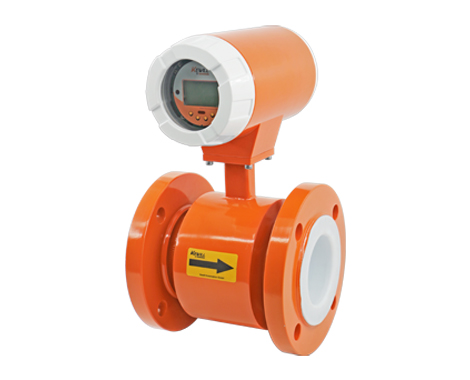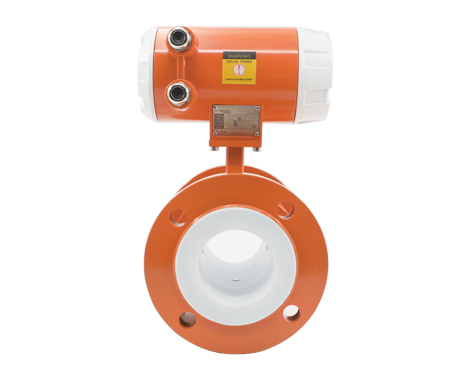Introduction
Principle & Structure
The measurement principle of the FE30H electromagnetic calorimeter is based on Faraday's law of electromagnetic induction: when the conductive liquid cuts the magnetic field line in the magnetic field, an induced potential is generated in the conductor, and the induced potential is E:
E=KBVD
In the formula: K——–instrument constant
In the formula: B————magnetic induction intensity
In the formula: V————the average flow velocity in the section of the measuring tube
In the formula: D——– measure the inner diameter of the pipe section
When measuring the flow rate, the conductive liquid flows through the magnetic field perpendicular to the flow direction at a speed V, the flow of the conductive liquid induces a voltage proportional to the average flow rate, and the induced voltage signal directly contacts the liquid through two or more The sensor electrode is detected, and sent to the converter through the cable for intelligent processing to realize the display of the instantaneous flow of the fluid, the display of the accumulated flow, and the communication between the flow data and the control system. There are no moving and blocking parts in the measuring tube, so there is almost no pressure loss and high reliability. The electromagnetic heat meter organically combines the electromagnetic flowmeter and the paired temperature sensor. Using the electromagnetic flowmeter to measure the flow, combined with the paired temperature sensor (PT1000), it can calculate, accumulate, store and display the heat absorbed or released in the heat exchange circuit. The flow and energy calculation unit CPU and sampling module of FE30H electromagnetic heat meter all use ARM single-chip microcomputer, which has large memory capacity and high reliability. The heat calculation can truly realize enthalpy calculation and achieve high accuracy.
Principle of energy metering
The FE30H electromagnetic heat meter calculates and displays the heat released or absorbed by the system according to the flow signal of the flow sensor and the temperature signal of the supply and return water detected by the paired temperature sensor, as well as the time when the water flows. The heat is displayed in the form of a meter, the unit is KWh, the resolution is 1KWh, and the maximum display is 9 digits. The mathematical calculation model is as follows:
In the formula: Q-the heat released or absorbed by the system, the unit is KWh; qm-the mass flow rate of the water flowing through the heat meter, the unit is kg/h; qv-the volume flow rate of the water flowing through the heat meter, the unit is m3/ h; ρ - the density of the water flowing through the heat meter, in kg/m3; Δh - the difference in the enthalpy of the water at the inlet and outlet temperatures of the heat exchange system. The unit is kJ/kg; τ-time, the unit is h.
Features & Benefits
● Electromagnetic calorimeter is an instrument for measuring volume flow, and the measurement results have nothing to do with physical parameters such as flow velocity distribution, flow pressure, temperature, density, viscosity, etc.;
● There are no moving parts in the measuring tube, which is convenient for maintenance and management, so the service life of the sensor is long; no blocking parts, no pressure loss;
● The conductivity of the liquid to be measured can be as low as 5μS/cm, and with various lining materials, it can be used to measure the flow of various acid and alkali media with high accuracy, usually ±0.5% of the flow accuracy;
● High-definition backlight LCD display, Chinese and English menu operation, easy to use, simple to operate, easy to learn and understand;
● The converter has reliable performance, high precision, low power consumption, stable zero point, convenient parameter setting, LCD display, which can display parameters such as cumulative flow, flow rate, and flow percentage;
● The water inlet direction can be bidirectional, and the installation is not restricted. Bidirectional measurement system, which can measure forward flow and reverse flow;
● Full digital processing, strong anti-interference ability, reliable measurement, high precision, flow measurement range up to 150:1;
● Ultra-low EMI switching power supply, using a wide range of power supply voltage changes, good EMC resistance;
● With RS485 digital communication signal output;
● It can be used to match the generally poor water quality of the air conditioning and heating circulation system;
● It can display parameters such as cumulative heat, cumulative flow, instantaneous flow, flow rate, water supply temperature, return water temperature, etc.;
● Correction with the change of water temperature to ensure accurate measurement under different water temperatures;
● Multi-level password setting function to prevent data from being maliciously modified.


